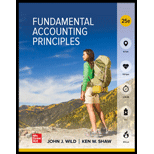
Concept Introduction:
Contribution margin
Contribution margin is the difference between sales price of a product and variable cost that results in the incremental profit earned for each unit sold. It means the contribution margin generated to meet the fixed cost and generate profit.
Requirement 1:
We have to determine the contribution margin per machine hour that product generates.
Concept Introduction:
Contribution margin
Contribution margin is the difference between sales price of a product and variable cost that results in the incremental profit earned for each unit sold. It means the contribution margin generated to meet the fixed cost and generate profit.
Requirement 2:
We have to determine the product mix if it operates in only one shift and contribution margin of such product mix.
Concept Introduction:
Contribution margin
Contribution margin is the difference between sales price of a product and variable cost that results in the incremental profit earned for each unit sold. It means the contribution margin generated to meet the fixed cost and generate profit.
Requirement 3:
We have to determine the product mix if it operates in two shifts and contribution margin of such product mix.
Concept Introduction:
Contribution margin
Contribution margin is the difference between sales price of a product and variable cost that results in the incremental profit earned for each unit sold. It means the contribution margin generated to meet the fixed cost and generate profit.
Requirement 4:
We have to determine whether it is profitable to increase the maximum production of product R to 675 units.
Want to see the full answer?
Check out a sample textbook solution
Chapter 25 Solutions
FUND.ACCT.PRIN.(LOOSELEAF)
- Can you provide the accurate answer to this financial accounting question using correct methods?arrow_forwardTotal unit cost for part Y isarrow_forwardQuestion 5: Acid-Test RatioA company has the following data: Cash: $50,000Accounts Receivable: $30,000Inventory: $60,000Current Liabilities: $70,000a) What is the company’s acid-test ratio?b) Is the company in a strong liquidity position based on this ratio? Need helparrow_forward
- I need help finding the accurate solution to this general accounting problem with valid methods.arrow_forwardProvide correct answer this accounting questionarrow_forwardRivera Corp. reported the following balances at the end of the year: Credit Sales: $320,000, Accounts Receivable: $85,000, Allowance for Uncollectible Accounts before adjustment: $1,500 debit. Rivera Corp. estimates that 6.5% of the credit sales are uncollectible. After the year-end adjustment, what is the Net Realizable Value of Accounts Receivable?arrow_forward
- I want answerarrow_forwardFinancial Accountingarrow_forwardQuestion 4: Depreciation (Straight-Line Method)A company purchases machinery for $50,000. The estimated salvage value is $5,000, and the useful life is 10 years. a) Calculate the annual depreciation expense.b) What will the book value of the machinery be after 4 years? explanation please.arrow_forward
- Question 4: Depreciation (Straight-Line Method)A company purchases machinery for $50,000. The estimated salvage value is $5,000, and the useful life is 10 years. a) Calculate the annual depreciation expense.b) What will the book value of the machinery be after 4 years? Explain.arrow_forwardWhat is the amount ans nature of the gain or loss from the sale ?arrow_forwardProvide answerarrow_forward

 AccountingAccountingISBN:9781337272094Author:WARREN, Carl S., Reeve, James M., Duchac, Jonathan E.Publisher:Cengage Learning,
AccountingAccountingISBN:9781337272094Author:WARREN, Carl S., Reeve, James M., Duchac, Jonathan E.Publisher:Cengage Learning, Accounting Information SystemsAccountingISBN:9781337619202Author:Hall, James A.Publisher:Cengage Learning,
Accounting Information SystemsAccountingISBN:9781337619202Author:Hall, James A.Publisher:Cengage Learning, Horngren's Cost Accounting: A Managerial Emphasis...AccountingISBN:9780134475585Author:Srikant M. Datar, Madhav V. RajanPublisher:PEARSON
Horngren's Cost Accounting: A Managerial Emphasis...AccountingISBN:9780134475585Author:Srikant M. Datar, Madhav V. RajanPublisher:PEARSON Intermediate AccountingAccountingISBN:9781259722660Author:J. David Spiceland, Mark W. Nelson, Wayne M ThomasPublisher:McGraw-Hill Education
Intermediate AccountingAccountingISBN:9781259722660Author:J. David Spiceland, Mark W. Nelson, Wayne M ThomasPublisher:McGraw-Hill Education Financial and Managerial AccountingAccountingISBN:9781259726705Author:John J Wild, Ken W. Shaw, Barbara Chiappetta Fundamental Accounting PrinciplesPublisher:McGraw-Hill Education
Financial and Managerial AccountingAccountingISBN:9781259726705Author:John J Wild, Ken W. Shaw, Barbara Chiappetta Fundamental Accounting PrinciplesPublisher:McGraw-Hill Education





